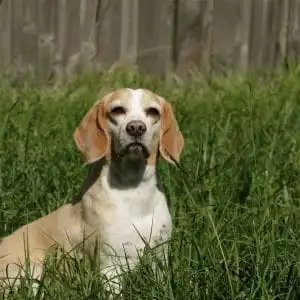You love your furry friend Fido, but your lawn does not. When your dog does his business outside, he leaves behind a pattern of burnt-out brown spots on the grass. These dead spots are harmful to your lawn’s overall health, as well as being visually unappealing. But how can you help your lawn when it’s under doggie duress? Here’s how to prevent dog urine damage.
How Dog Urine Damages a Lawn
Dog urine damage occurs when a pet prefers to pee in the same location again and again. Over a period of time, this area receives a concentrated amount of urine, which is rich in nitrogen. The roots of the grass absorb this overload of nitrogen, which causes grass to turn brown and eventually die.
A dog’s diet is high in protein, therefore, canine waste contains a lot of nitrogen. Both female and male dogs cause the damage, but females tend to be more frequent offenders. Why pick on females? Generally, the majority of female dogs usually squat in one location, while many male dogs opt for a variety of places.
Signs and Symptoms of Dog Urine Damage
Urine-burned blemishes look similar to lawn disease or pest infestation damage. Of course, if you follow Fido outside and watch where he does his business, you’ll know for sure. Look for roundish patches of dead grass that are brown in color and range anywhere from a few inches to over a foot in size. Sometimes these patches have a bright green border around the damaged area. This is because the nitrogen in the dog’s urine is the same ingredient in fertilizer. The center of the spot is getting a deadly overdose of nutrients, while the outer ring is getting just a little extra nitrogen. It’s experiencing the benefits of being fertilized, but will eventually succumb to the same outcome.
Solutions that Deal with the Dog
Obviously, the easiest way to stop dog urine damage is to keep your pet off the lawn, but that is not realistic. Fido needs to take his bathroom break somewhere, and you don’t always have time to take him for a walk or to the park. Training your dog to do his business in one location keeps the lawn lush in the rest of the yard. However, this solution takes time and patience. Start off with a larger area and take him there on a leash until he gets the hang of it. Pick a spot that’s out of the way or doesn’t have grass. Or better yet, create your own doggie zone with gravel, mulch, or artificial turf that won’t be harmed by urine.
Another solution is dilution. When your dog drinks more water, the urine is diluted and contains less concentrated nitrogen. Make sure your pet always has a fresh bowl handy.
There are dietary supplements you can give your dog to help counteract the high nitrogen, but these anecdotes may end up doing more harm to your pet than good for your lawn. Talk to your vet before you decide to make any dietary changes.
How to Help Your Lawn
- Fertilize less or don’t fertilize at all in burnt spots. You can also find fertilizers with reduced nitrogen.
- Pick a grass that can withstand extra stress. For example, fescue and perennial ryegrasses are more resistant to dog urine damage than Kentucky bluegrass and bermudagrass.
- Water down blemished areas after Spot marks his spot. This helps dilute the urine. You can use the hose or even a bucket of water.
- Reseed dead spots of grass. While this won’t stop the problem, it goes a long way in helping your lawn’s appearance.
- Consider landscape changes. Hardscaping your yard is an option if you aren’t too attached to green grass. Try paver stones or bricks in some or all of the yard. These are easy to rinse off, plus require much less maintenance.
Let Us Help
Fortunately, some smaller areas of dog urine damage will recover over time and with a little TLC. Larger areas require reseeding or special treatments. Contact Free Spray Lawn Care today at 419-529-5296, and we’ll help you stop Rover from ruining your lawn.



Comments (0)
Thanks for your comment!
Thanks for your feedback! Your comments have been successfully submitted! Please note, all comments require admin approval prior to display.
Error submitting comment!
There is a problem with your comment, please see below and try again.